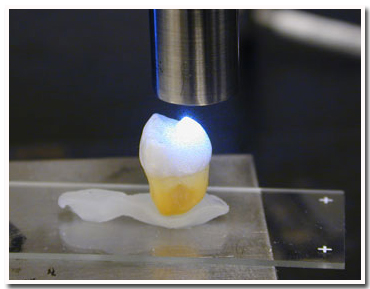Million Dollar Grant Makes NRC Oral Health Researchers Smile
Have you ever had a dental cavity? Have you ever wished you didn't have to undergo the ordeal of drilling and filling? An NRC research team has recently been awarded a grant totaling $1,078,480 US to tackle the problem of early assessment of dental decay. The grant, from the U.S. National Institutes of Health's National Institute of Dental and Craniofacial Research, is intended to help us avoid making those unwanted trips to the dentist.
Say Ahhh: Shining Light on Dental Caries
Working in collaboration with dental clinicians, the NRC Institute for Biodiagnostics (NRC-IBD) dental caries team are developing a technology that combines an imaging technique, optical coherence tomography (OCT) and Raman spectroscopy to detect cavities much earlier. The technology is non-invasive and uses non-ionizing radiation, unlike dental x-rays which are not suited for catching early lesions.
 |
| The research team will use Raman spectroscopy to investigate human teeth. |
Dental clinicians find it difficult to detect early dental decay and to monitor this ongoing decay using current diagnostic methods which rely on subjective clinical criteria and early lesions are often missed. As a result, lesions are undiagnosed until it's too late to avoid drilling and filling. Other lesions are unnecessarily restored despite the opportunity to stop decay and repair the lesion using non-surgical methods such as applying fluoride.
The dental caries team recognized the need to help dentists to:
- detect and assess early non-cavitated lesions;
- determine if invasive surgical restoration is necessary; and,
- monitor conservative treatment strategies to promote repair.
 |
| NRC-IBD staff and their collaborative researchers use optical coherence tomography to image a human molar |
Early detection of dental caries allows dentists to stop and reverse the damage using conservative methods like fluoride treatments (available in drinking water, toothpastes, mouthwash, topical applications) rather than the irreversible cutting and often painful restoration of the tooth structure. NRC-IBD's approach represents a new focus in dental care for better diagnosis and management of patients' dental and oral health.
The research team is a consortium led by the Spectroscopy Group at NRC-IBD (L.-P. Choo-Smith as principal investigator, M. Hewko, M. Sowa, A. Ko, J. Werner) and involves clinical collaborators from the University of Manitoba (C. Dong, W. Wiltshire, Colin Dawes) and from Dalhousie University (B. Cleghorn). Micro-optics engineers from Quebec's National Optics Institute (led by P. Topart at INO) are also involved. The grant follows previous grants from the Manitoba Medical Service Foundation and the Canadian Institutes of Health Research's Institute for Musculoskeletal Health and Arthritis (CIHR-IMHA) awarded to some members of the team.
The team's research is intended to support better diagnosis and management of dental decay with cost-effective and less invasive methods than traditional dental practices. This is expected to improve patients' oral health and the general wellbeing of individuals.
 |
| Representative false-colour OCT images from a) sound enamel (minimum light back-scattering with depth) and b) proximal incipient caries (significant light back-scattering) |
|
